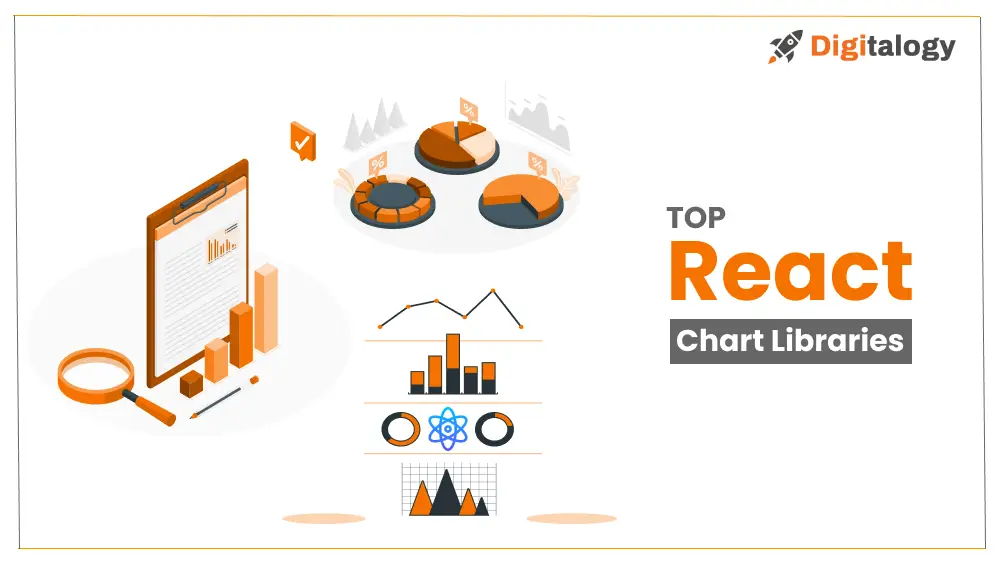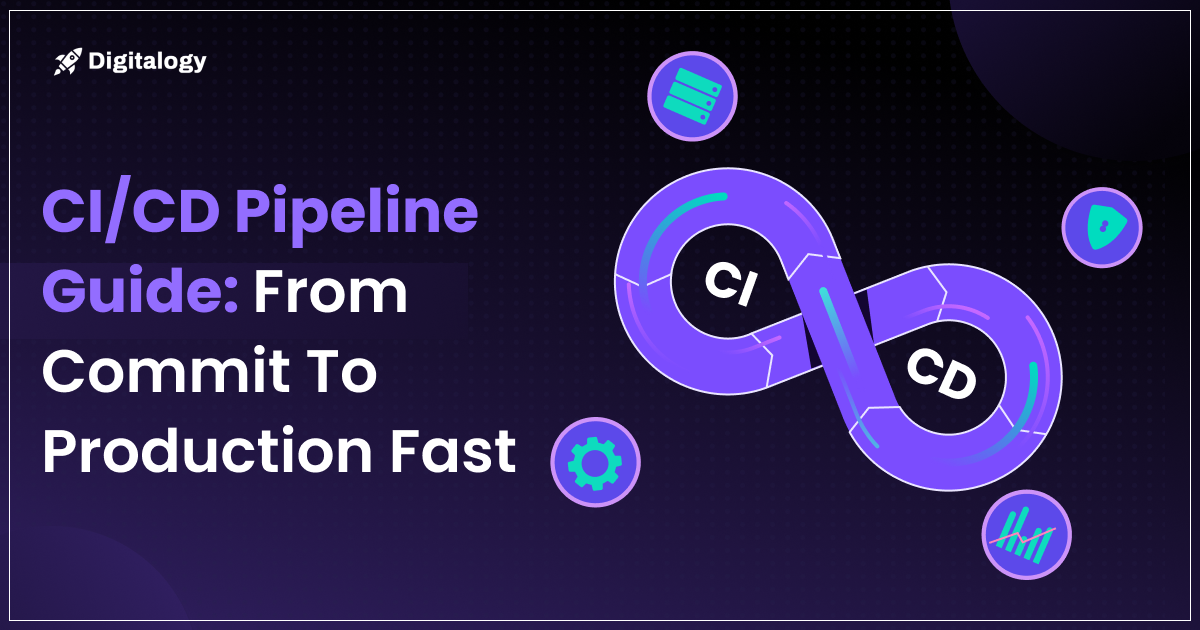There are numerous methods for displaying charts in your project when developing websites or applications. You have the option of creating your own customized charts from scratch or using one of the various React chart libraries that are offered.
The programmers have a close relationship with diagrams and charts. While carrying out a task, they obtain data straight from the database and present it in an appropriate manner. Making charts that are user-friendly, however, can sometimes be challenging. Therefore, to make the task easier, a skilled React JS engineer can use React Chart Libraries. This helps in saving a lot of time, and there are numerous options available to choose from.
In this blog, we will understand React Chart Library and its different types.
What Is A React Chart Library?
React Chart Library, or React apps as they are more popularly known, works on visualization of the data, management of libraries, enabling users to create and customize the elements, and helping them manage the data. These flexible and adaptable programs use frameworks that are extremely practical and long-lasting. React Admin Templates, however, can greatly improve your productivity just like the chart library does.
For developers who want to incorporate useful data into their web-based programs, ReactJS Chart Libraries are a useful tool. These applications essentially assist web designers in demonstrating how a specific application or functionality is now operating or is anticipated to do so in the upcoming time. They are a blessing for site designers since they can now concentrate on creating actual data instead of worrying about how to portray it.
A chart is a typical element of both web and mobile applications. Various chart formats offer various data. Digital charts are common as they make it possible for developers to comprehend and compile important data in styles that are appropriate for our purposes. The most common types of charts used with React comprise line charts, bar charts, pie charts, Gantt charts, and bubble charts.
React applications are also referred to as React chart libraries. These applications utilize frameworks that you can apply in the future and are robust and versatile. React chart libraries are a useful resource for web designers who want to include relevant data in their web applications.
List Of Top React Chart Libraries in 2024

- Recharts
Recharts is regarded as one of the best dependable react chart libraries and is consequently the most popular among experts and web developers. While offering native SVG compatibility throughout, it has a minimal dependence on certain D3 modules.
Recharts use entirely presentational elements, which is primarily due to the fact that they are expressive in nature.
Experts frequently suggest Recharts as the initial option for people looking for an effortless and straightforward method to complete their data visualization tasks.
The library has 544,578 npm downloads every week, which is a milestone. The program is well-liked by the developers and offers experts the most flexibility when it comes to the procedure of visual data analytics.
Pros:
- The API of Recharts is very intuitive.
- It has been created by React from scratch for React Libraries only.
- The charts can be created with customisation and can be reused.
Also read: 10 Best Python Frameworks For Web Development
- React ChartJS 2
React-chartjs-2 is not your typical react chart library, as you may already know if you are acquainted with the chartjs library. Alternatively, it is comprehended as a react layer for the JavaScript-specific charting package chartjs.
For the uninitiated, Chartjs is a react chart toolkit that is user-friendly for beginners. It leverages HTML5 Canvas elements to create chart elements that are distinct in their forms and sorts.
A developer needs to be aware of the Chartjs documentation before using React-chartjs-2. One is unlikely to encounter many issues in performing the same because the architecture is simple to understand. This react chart library is worth giving a try, with 338,760 average downloads every week.
Pros:
- Its user surface is very easy to understand which makes it beginner friendly.
- The documentation is very similar to Chartjs.
- The framework is very simple to understand hence it is very unlikely that there will be any usage issues.
- Victory
Victory is a well-known react chart library which is compatible with React and React Native. It features a number of charting elements and provides a uniform API across all projects. Users can produce data in the manner of charts for both iOS and Android-based device applications using the same API. Cross-platform charting is made easy by the library, which is also very simple to understand and utilize.
Furthermore, it enables the simple and easy integration of charts like line, pie, bar, and candlesticks into browser and React Native apps. Victory, created by Formidable, has a typical npm installation number of 126,898 per week.
Pros:
- It is compatible with both iOS and Android-based platforms.
- Features like zooming, animation, and transitions are also available.
- The documentation of the application is advanced and modular.
- Visx
Visx, which was created by Airbnb, is a fresh face in the React Chart Libraries category and has collected over 14.2k reviews on GitHub, representing a remarkable accomplishment. Visx’s ability to integrate React DOM and D3.js in a methodical manner is its most noteworthy flexibility when used as an operational repository.
Visx’s ability to integrate React DOM and D3.js in a methodical manner is its most noteworthy flexibility when used as an operational repository.
The fact that Visx’s creators need not describe it as a react chart library in the traditional sense is incredibly exciting. Rather, they see it as a compilation of low-level, potentially reusable visualization elements.
To get a greater and more in-depth grasp of how this simple framework actually operates, you can also check out the “Bar Chart Example Code” of it.
Pros:
- It is possible to create reusable visualization charts which are reusable.
- D3 is employed in this.
- Nivo
Nivo offers a cutting-edge method for website designers to produce graphs as well as other data on the application server. For the objectives of visual analytics and display, there are numerous and inventive templates accessible. The chart collection provides unique and appealing solutions for visually appealing significant data.
In addition to providing transitions, Nivo provides SVG, HTML, and Canvas charts together in a singular charting framework (or motions). Nivo serves as your one-stop store when you’re seeking for an accurate and adaptable answer to your visual analytics demands.
With variations in the charts, it claims to provide you with an exciting consumer experience.
Pros:
- It is highly customizable.
- Responsive charts.
- Interactive framework.
- React Vis
React vis is a leading name throughout the React Chart Libraries category and was created by the web designers at Uber Open Source. For your purposes in visual data analytics, it provides a fairly simple and quick method of understanding the plotting of elements.
Line, area, bar, pie, donut, contour plot, heat map, hexagon heat map, scatterplot, pie and donut charts, sunbursts, radar charts, parallel coordinates, and treemap are among the most popular data visualization charts that are accessible.
The flexibility to construct and select a variety of charts is a feature that users admire in the documentation. There are 8k stars on GitHub in a very short amount of time which proves this.
Pros:
- It is beginner-friendly for react developers.
- Simple integration with React.
- Flexible and user-friendly.
- BizCharts
In order to create efficient, competent, and useful visual analytics services for organizations’ frontend and backends, Alibaba created the universal React charting framework known as BizCharts. Built upon the React charting framework offered by G2 and G2 Plot, it has experienced three years of testing in Alibaba’s complex corporate environment.
In terms of utility, usefulness, and complexity, it satisfies the business implementation requirements for both conventional charts and fully personalized charts. They have a truly amazing and flexible collection of themes.
The greatest chart library to date is another reason why BizCharts is renowned for being a strong foundation for designing and visualization of data. The Asian population enjoys BizCharts greatly, with 27,247 npm installations recorded in a single week.
Pros:
- Solid platform for business growth.
- Almost all the charts for data visualization are supported.
- ES6 React Grammer.
- React Stock Charts
For individuals who are seeking visualization of their stock chart data in flexible yet clear layouts, this react chart library is a crucial tool. React stock charts are known for being your one-stop solution if you’re a web designer searching for a framework to handle your economic data visualization requirements.
The tool has 3.3k GitHub ratings and supports more than Sixty technical indicators. However, a lot of users overlook the fact that this react chart library doesn’t offer regular updates or other kinds of care.
Pros:
- There are over 60+ technical indicators.
- Easy adaption of various data types.
- Ant Design Chart
One of the greatest charting tools for React is “Ant Design Charts”, which is considerably more accessible for React computing stack students. It promotes exploration into how effectively the charts function in their simplest and basic configuration and automatically creates the best quality charts outside the box.
Users can easily modify a chart’s features to meet specific business requirements. The primary focus of both interactive and visual experiences is the display and discovery of content at the core objective of the chart.
Being a corporate-level React UI toolkit and designing a solution, it defines itself. Ant Design is, therefore unquestionably the finest Open-Source React Chart Library. This is due in part to the strong API, which offers a wealth of suggestions, demonstrations, and workarounds. It’s a fantastic platform for changing pre-existing components and layouts.
Pros:
- Ant Design has great documentation.
- Due to its easy-to-understand architecture, it is user-friendly.
- Like many other platforms, it is not heavy-weight and is unresponsive.
- E-charts for React
A great Open Source React Chart Library for corporate presentations is ECharts, which is a dynamic, intelligent, and user-friendly tool for charting and data visualization. ECharts for React is made with JavaScript. It makes use of the ZRender rendering engine, which is compatible with SVG and Canvas. The ZRender rendering engine also handles SVG and Canvas.
ECharts 5 expands upon the basic functionality of the earlier models and makes it even simpler for software developers to explain the meaning behind the sets of data by introducing new functions and enhancing current ones in story narration and data presence, enhanced visual representation and mobile responsiveness, partnership and quality betterment, developer experience, globalization, as well as other areas.
Pros:
- It allows cross-platform assistance.
- The library has special effects and allows you to change data.
- Easy mobile optimization.
- React Apex Charts
You can incorporate React-ApexCharts into your React app as a wrapping item for ApexCharts. Even better, you can create stunning React Charts using a JavaScript app. Furthermore, updating the information in your React chart is straightforward. Any change to the series component alone will start an automatic process to rebuild the chart.
You may create any kind of web app using this framework, which is very user-friendly for developers. SaaS apps, health and fitness apps, finance apps, educational apps, etc., are all simple to make with React Apex Charts.
Pros:
- It is built on Next.js v12.
- It has both dark and light layouts.
- It has RTL support.
- React Finance Charts
React Financial Chart has evolved greatly over time adding typescript syntax and bug corrections. In addition, the Open Source React chart library is a worthy substitute for the defunct react stock charts despite its relative lack of demand.
The stock chart can also be changed easily on this platform. Additionally, it enables you to add compound sets by modifying the width, shapes, and brushes, rendering it the most beneficial React Open Source Chart library.
Pros:
- It allows easy customization.
- It keeps evolving according to the needs of the user.
- It is a great alternative for react stock charts.
- Rumble charts
You can employ the React plugin to create customizable, flexible charts to display your information. Rumble Charts utilize D3. However, most of the time you probably wouldn’t feel it. This React graph chart library contains a wide variety of graph charts illustrative of opportunities.
Rumble-charts, a chart library for React, is among the anonymous charting libraries. It consists of a collection of components that enables you to create flexible, assemblable charts so you can visualize the data. This simple program takes advantage of contemporary templates.
Pros:
- It contains modern-day templates.
- It has employed D3.
- A wide library of elements.
- React Time Series Chart
Time series components can access an extensive react chart library utilizing react time series charts. This offers a collection of arranged charting elements that cater to flexible requirements.
The orderly visualization of time-series data, such as network activity, is made possible by react time series charts. They upgrade the framework with simple explanations and thorough documentation, rendering the cheap-to-run cost worthwhile.
This module was created especially for React to display time series data and network traffic. Time series charts are the main emphasis of the React library. They were created utilizing d3 and a greater level of functionalities in React. This library can be utilized for substantial descriptions and samples even if it isn’t continually modified or maintained.
Pros:
- It helps to meet flexible requirements.
- Even without regular updates, it can be used smoothly.
- It is D3 based.
Also read: Top 22 React Component Libraries For 2023
Conclusion
There are several benefits to using chart libraries with React, including easy integration, straightforward analysis, and the ability to create charts and graphs. A data visualization library made accessible in React apps simplifies your effort. Reduce your burden by utilizing the best top react chart libraries you understand present in the list above.
The React community strongly supports these open-source libraries, which have gotten considerable maintenance. Making the most precise visualizations of data is made easier with the best React chart libraries. The development of apps is aided by it as well. Choose a library, then, that meets all of your needs. You should be aware that each graphical library and chart aims to assist developers in achieving a certain goal when choosing the right ones to use in your React project.
Examine what each framework has to offer prior to deciding which one to hire. The ideal React library for presenting your charts will rely on the features you require and the requirements of your work.
Ans. Some of the finest React Chart Libraries are React Charts, Victory, Nivo, React ChartJS 2, Rumble Charts, BizCharts etc.
Ans. The most used React Chart Library is React Charts.
Ans. React apps can use charts as an element to create common data representations based on a wide range of series or datums.
Ans. To obtain the Chart property, first you have to import react-google-charts. The information for the chart must then be placed in a parameter that you must establish next. Simply altering the values in the array will allow you to alter the chart.
Ans. There are many npm programs that allow you to build charts in React; one specific program which makes it straightforward to create a React wrapper for a chart is called chart.js.







